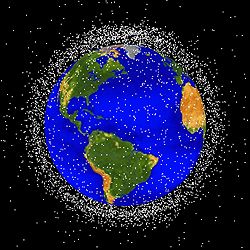New 'space fence' will help keep better track of space junk

The US Air Force has awarded contracts for a new "Space Fence" intended to track tens of thousands of pieces of space debris now orbiting the planet. Defunct satellites, spent rocket boosters, and objects as tiny as nuts and bolts are whipping around in low-earth orbit at speeds of 17,000 miles per hour, posing a hazard to existing spacecraft and astronauts. NASA estimates that there may be up to 500,000 pieces of junk orbiting the earth.

In fact, NASA reports, space shuttles need to re-directed away from hazards once a year or two, and the Russian Mir space station has suffered its share of dents and dings from space debris, as well as asteroids. The current International Space Station is "the most heavily shielded spacecraft ever flown," the space agency says.
Space.com reports that Raytheon Integrated Defense Systems and Lockheed Martin Mission Systems and Sensors were each awarded $107 million U.S. Air Force contracts to design a tracking system for all this junk.
The goal is to replace the current "Space Fence" -- a series of Very High Frequency radar sites that stretch across southern portion of the US -- with a more powerful system stretching across the globe. The current system was originally built in the early 1960s.
The new system will be capable of tracking a greater number of smaller objects in low and medium Earth orbit.
“The 2009 collision of an operational communications satellite with a defunct satellite illustrates the real risk space debris poses to both our manned and unmanned space missions,” according to John Morse, director of Lockheed Martin’s Space Fence program.
Next year, the Air Force will select one of the two companies to finalize and build the $3.5-billion system.
More information on the space junk problem is available at NASA's Orbital Debris Program Website.
This post was originally published on Smartplanet.com